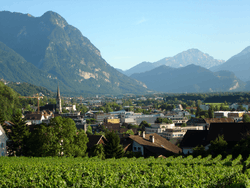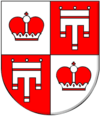Vaduz
| Vaduz | |||
|---|---|---|---|
 | |||
| |||
 | |||
| Coordinates: 47°08′28″N 9°31′16″E / 47.141°N 9.521°ECoordinates: 47°08′28″N 9°31′16″E / 47.141°N 9.521°E | |||
| Country |
| ||
| Villages | Ebenholz | ||
| Government | |||
| • Type | Monarchy | ||
| Area | |||
| • Total | 17.3 km2 (6.7 sq mi) | ||
| Elevation | 455 m (1,493 ft) | ||
| Population (31.12.2009) | |||
| • Total | 5,342 | ||
| • Density | 288/km2 (750/sq mi) | ||
| Time zone | CET (UTC+1) | ||
| • Summer (DST) | CEST (UTC+2) | ||
| Postal code | 9490 | ||
| Area code(s) | 7001 | ||
| ISO 3166 code | LI-11 | ||
| Website | www.vaduz.li | ||

Vaduz (German pronunciation: [faˈduːt͡s] or [faˈdʊt͡s]) is the capital of the principality of Liechtenstein and the seat of the national parliament. The town, located along the Rhine, has about 5,100 inhabitants (as of 2009),[1] most of whom are Roman Catholic. Its cathedral is the seat of the Roman Catholic Archbishop of Vaduz.
Although Vaduz is the best-known town internationally in the principality, it is not the largest: neighbouring Schaan has a larger population.
History
Vaduz is said to be mentioned in historic 12th-century manuscripts as Farduzes. It is, however, commonly believed to have been founded circa 1322 by the Counts of Werdenberg. In 1322 a mention of the castle is made, which was sacked by the Swiss in 1499 during the Swabian War. The entire town was also destroyed.
In the 17th century the Liechtenstein family was seeking a seat in the Imperial diet, the Reichstag. However, since they did not hold any territory that was directly under the Imperial throne, they were unable to meet the primary requirement to qualify.
The family yearned for the added power a seat in the Imperial government would bring, and therefore sought to acquire lands that would be Reichsunmittelbar, or held without any feudal personage other than the Holy Roman Emperor himself having rights on the land. After some time, the family was able to arrange the purchase of the minuscule Herrschaft ("Lordship") of Schellenberg and countship of Vaduz (in 1699 and 1712 respectively) from the Hohenems. Tiny Schellenberg and Vaduz possessed exactly the political status required: no feudal lord other than their comital sovereign and the suzerain Emperor.
Thereby, on January 23, 1719, after purchase had been duly made, Charles VI, Holy Roman Emperor, decreed Vaduz and Schellenberg were united, and raised to the dignity of Fürstentum (principality) with the name "Liechtenstein" in honour of "[his] true servant, Anton Florian of Liechtenstein". It is on this date that Liechtenstein became a sovereign member state of the Holy Roman Empire. As a testament to the pure political expediency of the purchases, the Princes of Liechtenstein did not set foot in their new principality for over 120 years.
Landmarks
The most prominent landmark of Vaduz is Vaduz Castle, the home of the reigning prince of Liechtenstein and the Liechtenstein princely family. The castle is visible from almost any location in Vaduz, being perched atop a steep hill in the middle of the city. The Cathedral of St. Florin, Government House and City Hall are also well-known landmarks, displaying the various styles and periods of architecture that the city is known for.
Economy and transport
Vaduz has a lively tourist industry, despite being one of the very few capital cities in the world without an airport or railway station.
The closest railway station is Schaan–Vaduz located around 2 kilometres (1 mile) from the city centre in the town of Schaan. However, very few trains stop here except for a local service between Buchs in Switzerland and Feldkirch in Austria. There are extremely frequent bus connections between nearby mainline railway stations including Buchs, Sargans, and Feldkirch, operated by Liechtenstein Bus.
Culture and sports
thumb|The Rheinpark Stadion is the home of FC Vaduz and the Liechtenstein national football team The National Art Gallery as well as the National Museum are located in Vaduz. The art gallery (Kunstmuseum Liechtenstein) is a museum of modern and contemporary art, also showing displays from the private princely Liechtenstein Collection, the main public display of which is in Vienna. The building is an architectural landmark built by the Swiss architects Morger, Degelo and Kerez. It was completed in November 2000 and forms a “black box” of tinted concrete and black basalt stone. The museum collection is also the national art collection of Liechtenstein. The Liechtenstein National Museum is showing a permanent exhibition on the cultural and natural history of Liechtenstein as well as special exhibitions. There are also the Postage Stamp Museum and a Ski Museum.
Vaduz also has a local professional association football club, FC Vaduz which, as the other clubs in Liechtenstein, plays in the Swiss Football League. In the 2008–09 season, FC Vaduz became the first Liechtenstein club to play in the Swiss Super League, Switzerland's top flight. The club play at the 8,000-capacity Rheinpark Stadion, which also hosts the Liechtenstein national football team.
Climate
Vaduz features an oceanic climate with mild summers and cool winters. Köppen-Geiger climate classification system classifies its climate as Marine West Coast Climate (Cfb).[2] The city experiences a noticeable increase in precipitation during the summer, but in general all twelve months see some precipitation. Vaduz receives, on average, approximately 900 mm (35.43 in) of precipitation per year. Vaduz’s warmest month, July, sees average high temperatures reach 25 °C (77 °F) while average low temperatures are about 14 °C (57 °F). The city’s coldest month, January, sees average highs of 3 °C (37 °F) and average lows of −3 °C (27 °F).
| Climate data for Vaduz (1981-2010) | |||||||||||||
|---|---|---|---|---|---|---|---|---|---|---|---|---|---|
| Month | Jan | Feb | Mar | Apr | May | Jun | Jul | Aug | Sep | Oct | Nov | Dec | Year |
| Average high °C (°F) | 4.3 (39.7) |
5.9 (42.6) |
11.1 (52) |
15.1 (59.2) |
19.8 (67.6) |
22.3 (72.1) |
24.5 (76.1) |
23.7 (74.7) |
19.7 (67.5) |
15.5 (59.9) |
8.9 (48) |
5.1 (41.2) |
14.7 (58.5) |
| Daily mean °C (°F) | 0.7 (33.3) |
2.0 (35.6) |
6.2 (43.2) |
9.9 (49.8) |
14.4 (57.9) |
17.0 (62.6) |
19.0 (66.2) |
18.4 (65.1) |
14.8 (58.6) |
10.9 (51.6) |
5.1 (41.2) |
1.8 (35.2) |
10.0 (50) |
| Average low °C (°F) | −2.8 (27) |
−1.8 (28.8) |
1.9 (35.4) |
4.8 (40.6) |
9.3 (48.7) |
12.1 (53.8) |
14.0 (57.2) |
13.9 (57) |
10.5 (50.9) |
6.7 (44.1) |
1.7 (35.1) |
−1.4 (29.5) |
5.7 (42.3) |
| Precipitation mm (inches) | 41 (1.61) |
38 (1.5) |
57 (2.24) |
55 (2.17) |
86 (3.39) |
115 (4.53) |
138 (5.43) |
142 (5.59) |
102 (4.02) |
63 (2.48) |
59 (2.32) |
52 (2.05) |
947 (37.28) |
| Snowfall cm (inches) | 14.2 (5.59) |
14.4 (5.67) |
6.4 (2.52) |
0.4 (0.16) |
0 (0) |
0 (0) |
0 (0) |
0 (0) |
0 (0) |
0 (0) |
4.7 (1.85) |
11.9 (4.69) |
52 (20.5) |
| Avg. precipitation days (≥ 1.0 mm) | 7.3 | 6.9 | 9.4 | 9.6 | 11.9 | 12.8 | 13.2 | 13.2 | 9.8 | 8.3 | 9.0 | 8.4 | 119.8 |
| Avg. snowy days (≥ 1.0 cm) | 3.9 | 3.9 | 2.1 | 0.2 | 0 | 0 | 0 | 0 | 0 | 0 | 1.4 | 3.3 | 14.8 |
| % humidity | 75 | 72 | 67 | 65 | 67 | 71 | 72 | 75 | 77 | 76 | 78 | 77 | 73 |
| Mean monthly sunshine hours | 70 | 91 | 124 | 144 | 166 | 170 | 194 | 177 | 145 | 116 | 68 | 52 | 1,516 |
| Source: MeteoSwiss [3] | |||||||||||||
Gallery
-

Rathaus
-

Government Building of Liechtenstein
-

City centre (here with Kunstmuseum Liechtenstein)
-

Cathedral of St. Florin
-

Vaduz Castle overlooking the city
Twin towns – Sister cities
Vaduz is twinned with
See also
- List of Foundations established in Vaduz
- Rheinpark Stadion
- Schaan-Vaduz railway station
- Vaduz Castle
- Vaduz Cathedral
Notes and references
- ↑ Estimate from "World Gazetteer". Archived from the original on 5 Jan 2013. accessed 18 May 2009
- ↑ Weatherbase climate summary accessed 12 August 2013.
- ↑ "Climate Norm Value Tables". Climate diagrams and normals from Swiss measuring stations. Federal Office of Meteorology and Climatology (MeteoSwiss). Retrieved 23 January 2013. The weather station elevation is 457 meters above sea level.
External links
![]() Media related to Vaduz at Wikimedia Commons
Media related to Vaduz at Wikimedia Commons
